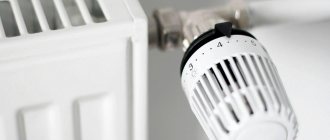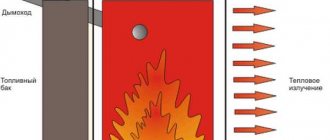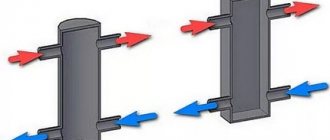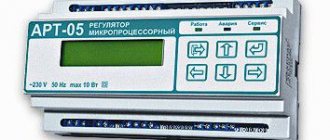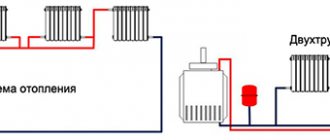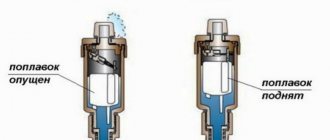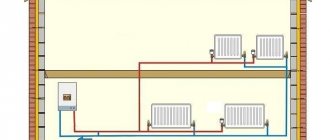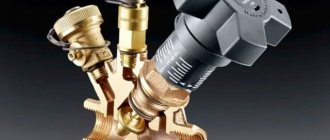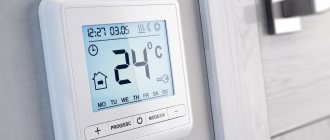Relevance of installing heating filters
Mechanical cleaning filter in a central heating system
What else causes changes in the composition of the coolant? Firstly, connect the make-up unit to the central water supply. In this case, mud filters for heating will retain most of the impurities.
In addition, there is another factor in the appearance of foreign elements in water. Even a carefully distilled coolant contains a certain percentage of mineral additives. As temperatures rise, it precipitates, forming limescale on the pipes. With sufficiently intense circulation, part of it enters the water in the form of particles of a fairly large fraction. An installed filter for the heating system will delay them, thereby leaving the system parameters at the proper level.
What filter elements should an autonomous heating system consist of?
- Preliminary rough cleaning . It is required to be installed when connecting to a central water supply to recharge the system. The optimal model is a sump filter in heating, in the flask of which all foreign components are collected;
- Fine cleaning . With its help, you can delay the movement of small particles whose size is less than 100 microns;
- Additional magnetic filters for heating . On their walls, made of a ferrimagnetic alloy, metallized particles remain - rust, chips from pipes, etc.
Selecting the most suitable filter models for heating must begin with a thorough analysis of each type.
Installing a dirt filter is mandatory, since even in an autonomous system with a well-treated coolant, rust from the pipes and boiler heat exchanger can get into the water.
Purpose, pros and cons of a mud filter
The mud filter for water is designed to clean and filter the coolant. If untreated water is used as a heat carrier, then it contains various impurities and salts that contribute to corrosion of the metal elements of the heating network. Salts also settle in the form of plaque on the internal walls of pipelines, causing a decrease in the lumen of the pipes and preventing the normal circulation of the coolant.
To clean the coolant from various debris and particles, mud collectors are installed in which small impurities settle and are then removed without dismantling or depressurizing the system.
The main advantages of using mud collectors:
- Filters protect circuits from becoming overgrown with dirt and deposits. This increases the service life of pipelines, heating devices and heating equipment.
- Due to the purification of the coolant, there is no need to change it frequently and use various expensive additives.
- If the circuit through which hard water circulates has many turns, then installing several filters completely solves the problem of pipeline clogging.
- An additional benefit is the preservation of the efficiency of the heating system due to the absence of deposits and debris. The efficiency of a “clean” system reaches 40%. This includes saving on electricity, because it is easier for the pump to pump coolant, and reducing fuel costs for the boiler.
- Ease of cleaning the circuit and reducing the likelihood of leaks due to corrosion are also important advantages of installing filters. The entire structure and devices will last much longer, and network maintenance costs will be reduced.
The only downside to using mud traps is the additional cost of purchasing them, but these minor costs are more than offset by the numerous benefits. To choose a suitable filter, you need to understand their types.
Rough water purification with heating filters
The main component of the system for retaining large enough pollutants is a coarse filter for heating. Depending on the layout and type of heating, its installation in several areas is required. There are several models of coarse filters, which differ not only in design, but also in the material of manufacture.
Dirt filter
Dirt filter for heating
The simplest design is an element installed on a certain section of the system. It contains a mesh catcher located in the branch pipe of the structure.
It is mounted on the connection to the central heating system. For autonomous circuits, its installation is mandatory at branch points, on the return pipe before connecting it to the boiler and on bypasses.
Depending on the design and material of manufacture, a mud filter for a heating system can be of the following types:
- By connection method - threaded, welded or flanged;
- By location - vertical or horizontal.
The most common brass models are designed for maximum temperatures up to 150°C at pressures above 2.5 MPa. Steel types have the same characteristics, but they are more susceptible to corrosion. For plastic pipelines there is a polymer filter for the heating system. However, their operating temperature is much lower than for the others - the maximum coolant temperature is +90°C.
Instructions for installing a mud filter
In order for the heating filter to properly perform its function, proper installation is necessary. The direction of movement of the coolant must be indicated on the body of the device. If you install it the other way around, then in addition to the lack of filtration, additional hydraulic resistance will arise.
It is also necessary to periodically clean the mesh from accumulated dirt and debris. To do this, there is a screw cap on the outlet pipe that can be removed. But first you must block the flow of coolant in this section of the pipeline.
A filter with a mesh for the heating system will protect the circulation pump from debris getting into the blades. If it is not installed, the likelihood of the impeller and motor failing increases significantly.
Sump filter
Sump filter with air separator
This is an improved model that allows you to avoid carrying out maintenance work for a long time. The specific design of a dirt filter for heating with a sump is the presence of a flask located at the bottom. Foreign components, lingering on the metal mesh under the influence of gravity, sink to its bottom. The flask is made of heat-resistant transparent plastic, which allows you to visually monitor the degree of contamination of the element.
Often, to reduce the oxygen content in water, a separator is installed in the same housing with the filter for the heating system. As the coolant passes through the filter, air is released, which is concentrated in the upper part of the structure. When a certain pressure value is reached, the drain valve opens.
The advantages and features of installing a similar model of coarse filter for heating are as follows:
- Possibility to visually control the degree of filling of the flask. A tap is installed below to drain contaminated liquid;
- Reducing the air content in water leads to minimizing corrosion processes on steel elements of the system;
- Installation is carried out almost immediately after the heating boiler. It is in this part of the pipeline that the temperature and pressure of the coolant are maximum, which contributes to better operation of the separator.
But you need to take into account the big difference in cost. The average price of a mud filter for a heating system is about 140 rubles. At the same time, a combined model with an air separator will cost much more - up to 7 thousand rubles.
Be sure to check the material used to make the flask at the settling filter. It should be heat-resistant plastic that will not lose its shape when exposed to high temperatures.
Principle of operation
The principle of operation of the filter is quite simple. Water enters the pipe and then goes into the internal cavity of the housing. And inside the body, suspended particles fall to the bottom in the form of sediment. The filter is installed inside the outlet pipe. The water passes through the filter and enters the heating system in purified form. To clean the mud trap from sediment, you need to remove the glass from the outlet pipe. The mud trap can be with a flange or threaded connection.
The sump device is a pipeline expansion unit that changes the direction of water flow, as well as filtering it with a mesh. Cutting off occurs under a special mesh, as well as the accumulation of large and medium fractions and precipitation.
The function of the mud collector is simple: it takes in contaminated water, purifies it and then removes the purified water. But it is recommended to periodically clean the lower part of the case from accumulated dirt.
But there is one nuance under which a mud filter for a heating system will work normally: the condition of a gradual increase in hydraulic resistance according to the readings of instruments on the pipeline line before and after the mud filter must be met.
Fine filter
Fine filter
In autonomous systems, it is preferable to install an additional fine filter. It differs from the types discussed above in that a cassette is used as the main component. Depending on the design, it can have either a cylindrical or square shape. The latter is very rare, since the production of such species is associated with certain difficulties.
When choosing, you need to pay attention that the filter model for the heating system is designed for sufficiently high temperatures. If you install an analogue for water supply, the housing or filter element may be damaged under the influence of hot water. Another factor is throughput - it should not be less than the calculated pressure in the system. Typically this is 7.2 m³/hour.
What other parameters are important for a fine filter intended for installation in a heating system?
- Possibility of wall mounting . This is important for plastic pipelines, in which an increase in load due to filling the flask with water is not allowed;
- Filter element manufacturing material . For heating, it is best to purchase mesh models made of metal;
- Maximum temperature and pressure values.
How relevant is the installation of fine filters for heating? If pre-treatment of the coolant has been carried out, you can do without them. In addition, when using antifreeze, installing a fine filter is prohibited. The density of the coolant will be much higher than that of water. This will make it difficult for it to flow through the filter element. The average cost of this heating component ranges from 2.2 to 4 thousand rubles.
A small increase in the budget for installing or upgrading heating with filters (mud, magnetic, settling tanks) will reduce the likelihood of an emergency.

